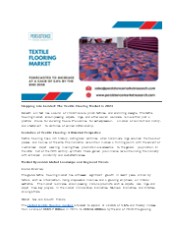Embedded Temperature Sensor Market PowerPoint PPT Presentations
All Time
Recommended
Embedded Temperature Sensor Market, By Type (Non-contact (Infrared and Fiber Optic) and Contact (Bimetallic, Temperature Sensor IC, Thermistor, Resistive Temperature Detector, and Thermocouple)), End-use Industry (Chemicals, Oil & Gas, Energy & Power, Healthcare, Food & Beverages, Consumer Electronics, Aerospace & Defense, and Metals & Mining), and by Region (North America, Europe, Asia Pacific, Latin America, and Middle East and Africa) - Size, Share, Outlook, and Opportunity Analysis, 2020 - 2027
| PowerPoint PPT presentation | free to download
biosensors market is expected to grow from USD 21.2 billion in 2019 to USD 31.5 billion by 2024, at a CAGR of 8.3%
| PowerPoint PPT presentation | free to download
Biosensors Market Research Report, identifies new revenue opportunity in biosensors industry. The report aims at estimating the market size and future growth of the biosensors based on offering, process, application, vertical, and region
| PowerPoint PPT presentation | free to download
The wearable sensors market is expected to grow from USD 189.4 Million in 2015 to USD 1,654.0 Million by 2022, at a CAGR of 30.14% between 2016 and 2022.
| PowerPoint PPT presentation | free to download
Global Smart Sensors Market is estimated to reach $101 Billion by 2025; growing at a CAGR of 18.5% from 2017 to 2025.
| PowerPoint PPT presentation | free to download
Wearable sensor market global forecast report categorizes global market by Type (Accelerometers, Magnetometers, Gyroscopes, Image Sensors, Inertial Sensors, Temperature & Humidity Sensors, Pressure & Force Sensors, Touch Sensors and Motion Sensors), Application (Wristwear, Eyewear, Bodywear), Vertical, and Geography.
| PowerPoint PPT presentation | free to download
The wearable sensors market is expected to grow from USD 189.4 Million in 2015 to USD 1,654.0 Million by 2022, at a CAGR of 30.14% between 2016 and 2022
| PowerPoint PPT presentation | free to download
the overall wearable sensors market was valued at USD 189.4 Million in 2015 and is expected to reach USD 1,654.0 Million by 2022, growing at a CAGR of 30.14% between 2016 and 2022
| PowerPoint PPT presentation | free to download
The wearable sensors market is expected to grow from USD 189.4 Million in 2015 to USD 1,654.0 Million by 2022, at a CAGR of 30.14% between 2016 and 2022
| PowerPoint PPT presentation | free to download
Biosensors market is expected to reach $31.5 billion USD by 2024 from $21.2 billion USD in 2019, at a CAGR of 8.3% during the forecast period
| PowerPoint PPT presentation | free to download
The global automotive embedded systems market is expected to reach $38.30 billion by 2030, at a CAGR of 5.44% during the forecast 2022-2030. Read More.
| PowerPoint PPT presentation | free to download
The wearable sensors market is expected to grow from USD 189.4 Million in 2015 to USD 1,654.0 Million by 2022, at a CAGR of 30.14% between 2016 and 2022
| PowerPoint PPT presentation | free to download
The wearable sensors market is expected to grow from USD 189.4 Million in 2015 to USD 1,654.0 Million by 2022, at a CAGR of 30.14% between 2016 and 2022.
| PowerPoint PPT presentation | free to download
The wearable sensors market is expected to grow from USD 189.4 Million in 2015 to USD 1,654.0 Million by 2022, at a CAGR of 30.14% between 2016 and 2022.
| PowerPoint PPT presentation | free to download
Wearable sensor market global forecast report categorizes global market by Type (Accelerometers, Magnetometers, Gyroscopes, Image Sensors, Inertial Sensors, Temperature & Humidity Sensors, Pressure & Force Sensors, Touch Sensors and Motion Sensors), Application (Wristwear, Eyewear, Bodywear), Vertical, and Geography. http://www.marketsandmarkets.com/Market-Reports/wearable-sensor-market-158101489.html
| PowerPoint PPT presentation | free to download
The wearable sensors market is expected to grow from USD 189.4 Million in 2015 to USD 1,654.0 Million by 2022, at a CAGR of 30.14% between 2016 and 2022.
| PowerPoint PPT presentation | free to download
The wearable sensors market is expected to grow from USD 189.4 Million in 2015 to USD 1,654.0 Million by 2022, at a CAGR of 30.14% between 2016 and 2022.
| PowerPoint PPT presentation | free to download
The wearable sensors market is expected to grow from USD 189.4 Million in 2015 to USD 1,654.0 Million by 2022, at a CAGR of 30.14% between 2016 and 2022
| PowerPoint PPT presentation | free to download
The wearable sensors market is expected to grow from USD 189.4 Million in 2015 to USD 1,654.0 Million by 2022, at a CAGR of 30.14% between 2016 and 2022
| PowerPoint PPT presentation | free to download
The wearable sensors market is expected to grow from USD 189.4 Million in 2015 to USD 1,654.0 Million by 2022, at a CAGR of 30.14% between 2016 and 2022
| PowerPoint PPT presentation | free to download
The wearable sensors market is expected to grow from USD 189.4 Million in 2015 to USD 1,654.0 Million by 2022, at a CAGR of 30.14% between 2016 and 2022.
| PowerPoint PPT presentation | free to download
The wearable sensors market is expected to grow from USD 189.4 Million in 2015 to USD 1,654.0 Million by 2022, at a CAGR of 30.14% between 2016 and 2022
| PowerPoint PPT presentation | free to download
The wearable sensors market is expected to grow from USD 189.4 Million in 2015 to USD 1,654.0 Million by 2022, at a CAGR of 30.14% between 2016 and 2022
| PowerPoint PPT presentation | free to download
The wearable sensors market is expected to grow from USD 189.4 Million in 2015 to USD 1,654.0 Million by 2022, at a CAGR of 30.14% between 2016 and 2022.
| PowerPoint PPT presentation | free to download
More Information @ http://bit.ly/2Aemfcc Automotive application segment of Smart sensors market will collect significant revenue over the years ahead, owing to the installation of sensor based systems. The automotive sector is gaining prominence across APAC, subject to which Asia Pacific Smart sensors market will generate lucrative revenue over the coming timeframe, subject to the usage of Smart sensorss in connected cars.
| PowerPoint PPT presentation | free to download
biosensors market is expected to grow from USD 21.2 billion in 2019 to USD 31.5 billion by 2024, at a CAGR of 8.3%
| PowerPoint PPT presentation | free to download
The wearable sensors market is expected to grow from USD 189.4 Million in 2015 to USD 1,654.0 Million by 2022, at a CAGR of 30.14% between 2016 and 2022.
| PowerPoint PPT presentation | free to download
The wearable sensors market is expected to grow from USD 189.4 Million in 2015 to USD 1,654.0 Million by 2022, at a CAGR of 30.14% between 2016 and 2022.
| PowerPoint PPT presentation | free to download
The wearable sensors market is expected to grow from USD 189.4 Million in 2015 to USD 1,654.0 Million by 2022, at a CAGR of 30.14% between 2016 and 2022.
| PowerPoint PPT presentation | free to download
The global Wearable Computing Market is estimated to surpass $92.1 billion mark by 2026 growing at an estimated CAGR of more than 20.1% during the forecast period 2021 to 2026.
| PowerPoint PPT presentation | free to download
Wearable Sensors Market by Application (Wristwear, Eyewear, Bodywear), Vertical, and Geography - Global Forecast to 2022
| PowerPoint PPT presentation | free to download
The wearable sensors market is expected to grow from USD 189.4 Million in 2015 to USD 1,654.0 Million by 2022, at a CAGR of 30.14% between 2016 and 2022
| PowerPoint PPT presentation | free to download
The wearable sensors market is expected to grow from USD 189.4 Million in 2015 to USD 1,654.0 Million by 2022, at a CAGR of 30.14% between 2016 and 2022.
| PowerPoint PPT presentation | free to download
This RTLS market reports includes the detailed analysis of market dynamics, Porter’s Five Forces model, value chain, competitive landscape, and market scenario during the forecast period. The market has been segmented and forecast based on product, technology, application, and region See Full Report : http://bit.ly/1HKgIK5
| PowerPoint PPT presentation | free to download
The wearable sensors market is expected to grow from USD 189.4 Million in 2015 to USD 1,654.0 Million by 2022, at a CAGR of 30.14% between 2016 and 2022.
| PowerPoint PPT presentation | free to download
An evolvable Network of Tiny Sensors ANTS for Public and EPC Sensor Network
| PowerPoint PPT presentation | free to view
The wearable sensors market is expected to grow from USD 189.4 Million in 2015 to USD 1,654.0 Million by 2022
| PowerPoint PPT presentation | free to download
The wearable sensors market is expected to grow from USD 189.4 Million in 2015 to USD 1,654.0 Million by 2022, at a CAGR of 30.14% between 2016 and 2022.
| PowerPoint PPT presentation | free to download
deals with flow level temperature and light sensors
| PowerPoint PPT presentation | free to download
The textile industry, a cornerstone of global trade for millennia, is undergoing a revolution driven by innovation. Smart textiles, fabrics embedded with technology that offer new functionalities, are transforming the way we interact with clothing. This blog dives into the smart textile market, exploring its growth, applications, and impact on the broader apparel and textile industry.
| PowerPoint PPT presentation | free to download
Sensors data processing from temperature sensors and up to current and voltage ... Security systems development that is reliable, and fulfill time to market needs ...
| PowerPoint PPT presentation | free to view
elastic electronics market By Component (Batteries, Circuits, Conductors, Sensors, Energy Harvesters, and Photovoltaic), By Applications (Consumer Electronics, Automotive, Aerospace & Defense, Healthcare, Textiles) –Forecast Till 2023
| PowerPoint PPT presentation | free to download
basics , design, hardware software, applications
| PowerPoint PPT presentation | free to download
An embedded system is a computer system with a dedicated function within a larger mechanical or electrical system, often with real-time computing constraints.
| PowerPoint PPT presentation | free to view
* * * * * * * * * * * * * * * * * * * * * * * * * * * * * * * * * * * * * * * * * * * * Problems of Short Range Molecular Communication Calcium Signaling Very high ...
| PowerPoint PPT presentation | free to download
As per Cognitive Market Research's latest published report, the Global Smart Packaging market size was $41.34 Billion in 2022 and it is forecasted to reach $65.14 Billion by 2030. Smart Packaging Industry's Compound Annual Growth Rate will be 5.8% from 2023 to 2030.
| PowerPoint PPT presentation | free to download
Surgical site infections (SSIs) continue to be a major challenge in healthcare, leading to longer hospital stays, additional treatments. Read more into our blog
| PowerPoint PPT presentation | free to download
Wireless sensor networks http://www.eecs.harvard.edu * * * * * * * * * * * * * * * * * * * The 8051 Microcontroller and Embedded Systems CHAPTER 8 ...
| PowerPoint PPT presentation | free to download
Embedded Systems: Introduction Prof. Santanu Chaudhury Prof. Wajeb Gharibi
| PowerPoint PPT presentation | free to view
... to Embedded System Concepts. A review of hardware ... Real Time System Concepts. Specification Languages. System Design. Partitioning. Design Quality ...
| PowerPoint PPT presentation | free to view
Explore how you can introduce modularity in embedded product development to reduce time-to-market and cost, by using Computer on Module.
| PowerPoint PPT presentation | free to download
According to the latest research report by IMARC Group, The global smart textiles market size reached US$ 4.1 Billion in 2023. Looking forward, IMARC Group expects the market to reach US$ 24.6 Billion by 2032, exhibiting a growth rate (CAGR) of 21.5% during 2024-2032. More Info:- https://www.imarcgroup.com/smart-textiles-market
| PowerPoint PPT presentation | free to download
Covid-19 Impact on Stretchable Electronics market By Component (Batteries, Circuits, Conductors, Sensors, Energy Harvesters, and Photovoltaic), By Applications (Consumer Electronics, Automotive, Aerospace & Defense, Healthcare, Textiles) –Forecast Till 2023
| PowerPoint PPT presentation | free to download
digital enabling technology is hidden inside the product such as TV remote ... embedded processor for scanning the keys and sending the data to the motherboard ...
| PowerPoint PPT presentation | free to view
Trends Shaping the Textile Flooring Market in 2023 The Textile Flooring Market continues to evolve, reflecting dynamic trends within the broader floor covering industry. Renowned for its versatility and aesthetic allure, this market segment encompasses carpets, rugs, and other fabric-based materials employed in residential and commercial settings. As an integral aspect of interior design, textile flooring is increasingly acknowledged for its comfort, durability, and its role in enhancing the overall ambiance of a given space.
| PowerPoint PPT presentation | free to download
Temperature controller controls the temperature of any device according to its requirement for any industrial application. It also displays the temperature on an LCD displays in the range of – 55°C to +125°C. At the heart of the circuit is the microcontroller from 8051 family which controls all its functions.
| PowerPoint PPT presentation | free to download
























































